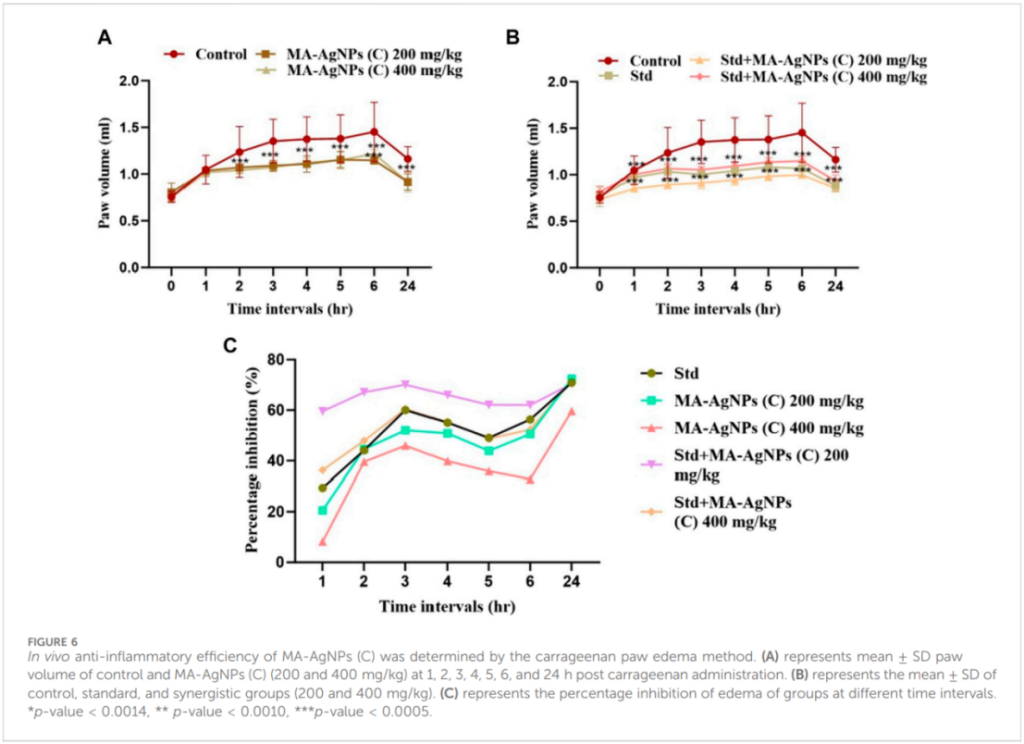
Silver in Medicine: A Journey Through Time
Inflammation is a natural defense mechanism that allows the immune system to identify and eliminate harmful stimuli while aiding tissue repair and maintaining homeostasis. However, when this process is disrupted, it can contribute to the development of various pathological conditions. Current treatments for inflammation, including steroidal and non-steroidal anti-inflammatory drugs, are effective but often lead to dose-dependent adverse effects. This underscores the urgent need for safer and more effective therapeutic options to manage inflammatory disorders.
Silver has been revered for its medicinal properties for centuries, particularly for its antibacterial capabilities. With the advent of nanotechnology, silver’s applications have been reimagined, leading to the development of silver nanoparticles (AgNPs). These nanoparticles exhibit a wide range of therapeutic activities, including antibacterial, anticancer, anti-inflammatory, and antioxidant effects. The synthesis method and choice of reagents play a critical role in determining their therapeutic potential. This study focuses on malonic acid-capped silver nanoparticles (MA-AgNPs), synthesized using sodium borohydride at low temperatures.
A Collaborative Mission for Innovation

This groundbreaking study, led by Tehrim Fatima and a multidisciplinary team at Dow University of Health Sciences in Karachi, Pakistan, was recently published in Frontiers in Pharmacology. The researchers aimed to evaluate the safety and efficacy of MA-AgNPs through rigorous in vitro and in vivo assessments. By exploring their therapeutic potential as anti-inflammatory, antinociceptive, and antioxidant agents, the team hopes to revolutionize drug delivery systems.
Crafting Nanoparticles: Precision and Methodology
The researchers synthesized MA-AgNPs using a chemical reduction method at low temperatures, employing malonic acid as a stabilizing agent and sodium borohydride as a reducing agent. This meticulous process ensures particle stability and optimized therapeutic properties. Experimental approaches included toxicity testing in animal models, gene expression analyses of inflammatory markers (TNF-α and IL-6), and antioxidant assessments using the DPPH assay. The study also incorporated statistical techniques like ANOVA to validate results.
Revealing the Therapeutic Potential of MA-AgNPs
The study yielded compelling data that highlight the therapeutic promise of malonic acid-capped silver nanoparticles (MA-AgNPs). Acute and sub-acute toxicity testing, conducted in adherence to OECD guidelines, showed that MA-AgNPs were well-tolerated at doses up to 2,000 mg/kg in animal models, with no significant toxic signs or mortalities. Histopathological examination revealed only minor changes in liver and kidney architecture, affirming the safety of these nanoparticles.
The anti-inflammatory efficacy of MA-AgNPs was evaluated both in vitro and in vivo. In the protein denaturation assay, MA-AgNPs alone inhibited protein denaturation by up to 61.48% at 850 μg/mL. When combined with diclofenac sodium, this inhibition increased to 72.09%, underscoring their synergistic potential. In vivo, the carrageenan-induced paw edema model demonstrated a 72.41% reduction in inflammation at a dose of 200 mg/kg of MA-AgNPs. When combined with diclofenac, the inhibition reached 71.42%, comparable to the standard drug alone (70.93%). These results suggest a potential mechanism involving the suppression of cyclooxygenase (COX) activity and pro-inflammatory prostaglandin synthesis.

Antinociceptive activity was assessed using the tail-flick and acetic acid-induced writhing tests. MA-AgNPs alone provided up to 44.24% pain protection at 200 mg/kg. This significant reduction in pain-related behaviors highlights their potential as effective analgesic agents, especially when used in combination with standard treatments.
The study also examined the nanoparticles’ impact on gene expression of inflammatory markers. MA-AgNPs reduced the expression of TNF-α and IL-6 in treated groups, with synergistic combinations achieving the most pronounced reductions. For example, TNF-α expression dropped from 323.37 in the control group to as low as 1.745 in the synergistic group (400 mg/kg MA-AgNPs with diclofenac). A similar trend was observed for IL-6 expression, demonstrating the nanoparticles’ strong anti-inflammatory properties at the molecular level.

In antioxidant evaluations, MA-AgNPs exhibited significant radical scavenging activity, with an 81.7% inhibition rate at a concentration of 1 mM in the DPPH assay. This activity decreased at higher concentrations, suggesting dose-dependent effectiveness. Additionally, reduced superoxide dismutase (SOD) levels in treated groups correlated with decreased inflammation and oxidative stress.

These findings establish MA-AgNPs as a promising therapeutic tool, with a safe toxicity profile, strong anti-inflammatory effects, and significant antinociceptive and antioxidant activities. Their potential to enhance standard treatments through synergistic effects could pave the way for more effective and safer therapeutic strategies.
Bridging the Gap: Implications and Future Directions
This study underscores the potential of MA-AgNPs as safer alternatives to conventional anti-inflammatory drugs. Their ability to reduce oxidative stress, alleviate pain, and enhance drug efficacy through synergistic applications positions them as promising agents for future clinical use. However, the research highlights the need for further exploration into the mechanisms underlying their therapeutic effects and long-term safety. Expanding studies to human trials and optimizing nanoparticle formulations could unlock new avenues in nanomedicine.
Conclusion
The research on malonic acid-capped silver nanoparticles signifies a critical step toward safer and more efficient drug delivery systems. By combining historical wisdom with modern nanotechnology, this innovative approach addresses pressing medical challenges. As scientists delve deeper into nanoparticle optimization, the horizon brightens for groundbreaking advancements in treating inflammation and pain.
Reference:
Fatima, Tehrim, et al. “Molecular marker identification, antioxidant, antinociceptive, and anti-inflammatory responsiveness of malonic acid capped silver nanoparticle.” Frontiers in Pharmacology 14 (2024): 1319613.
